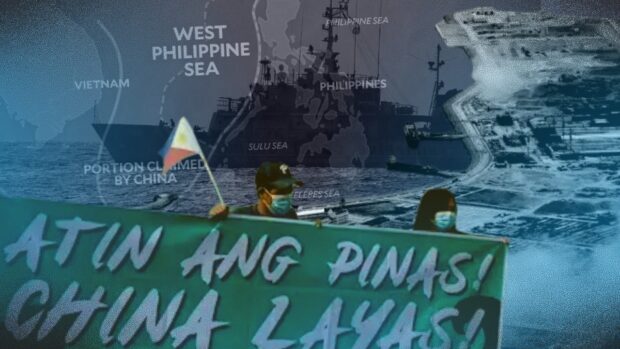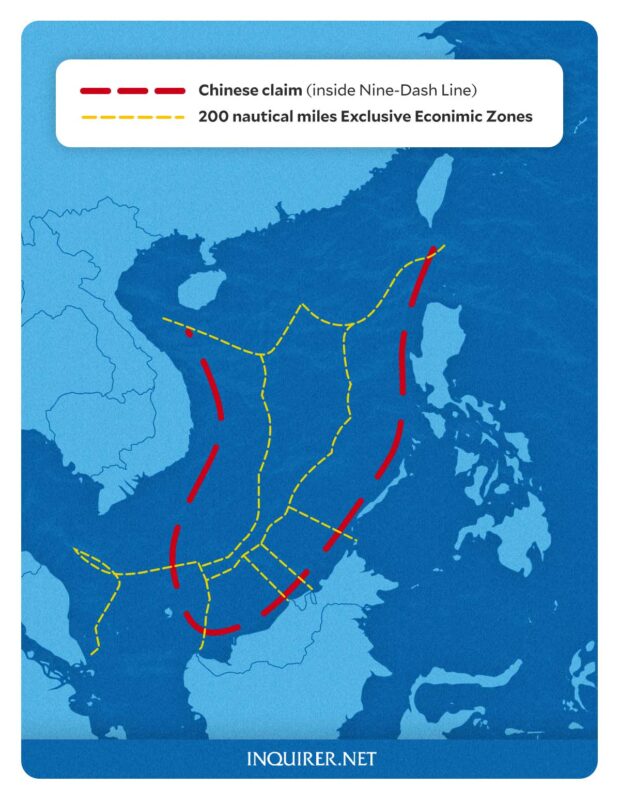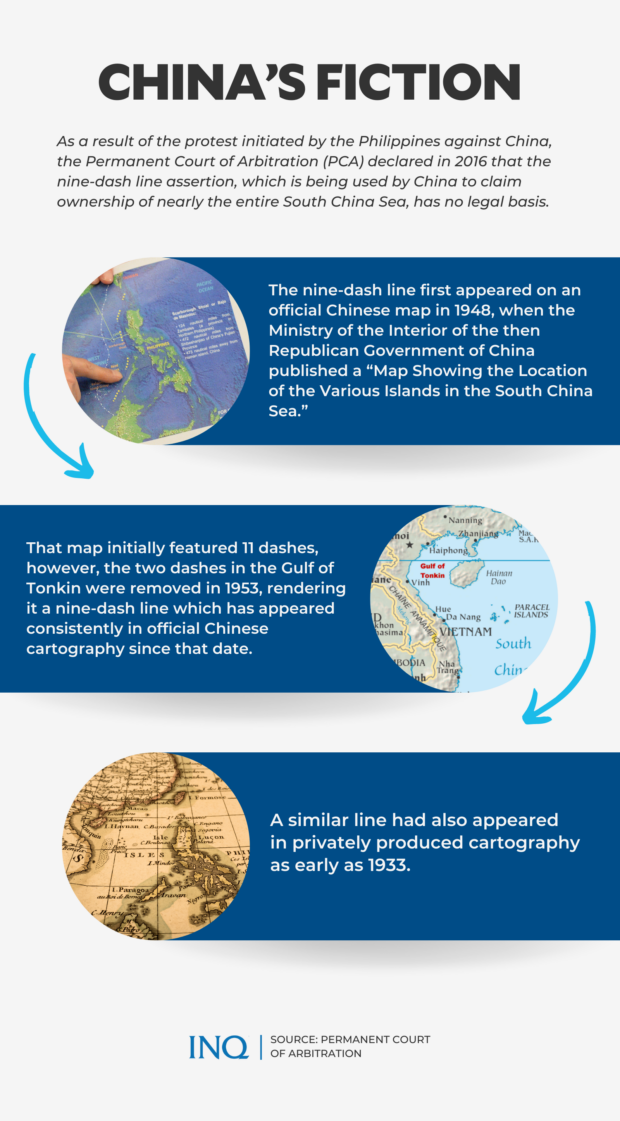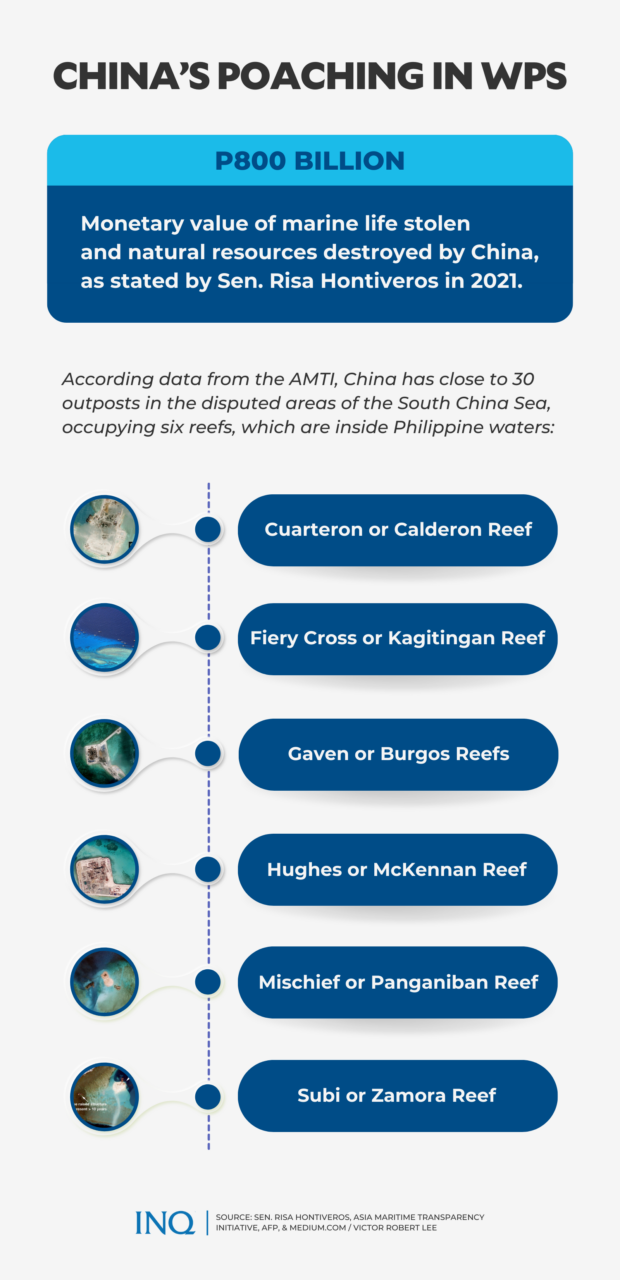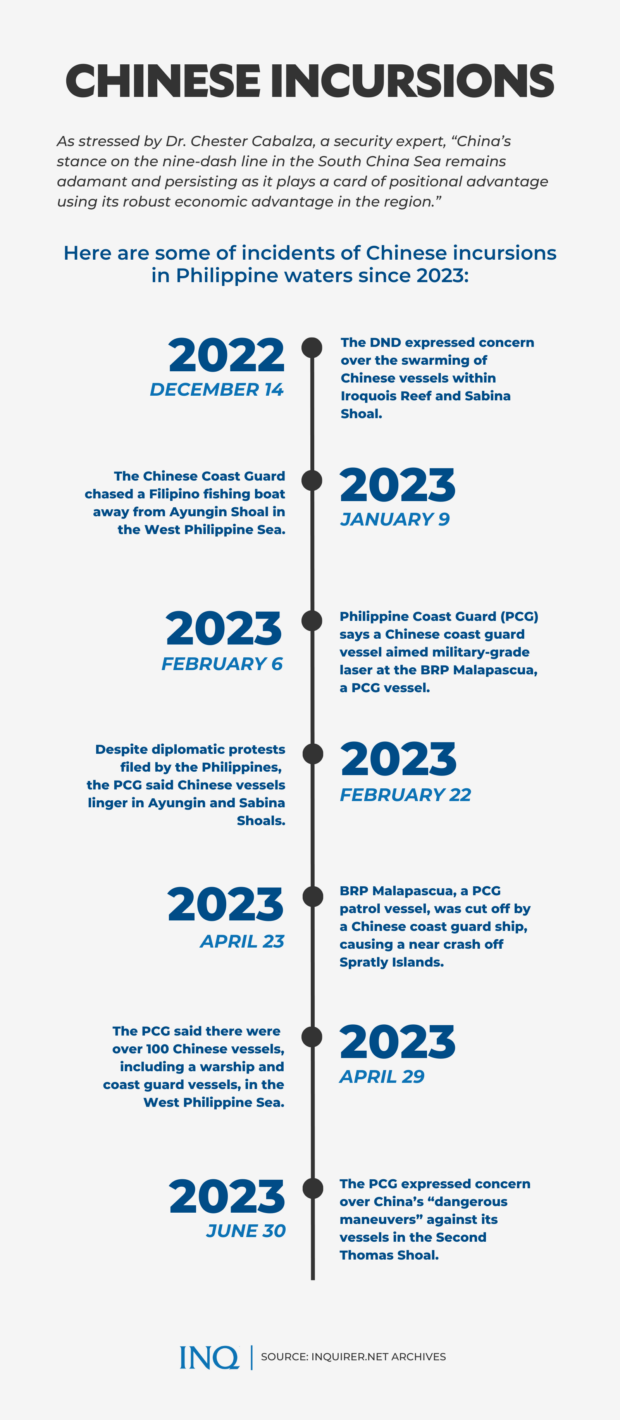China’s nine-dash line: A dangerous fiction even in the movies
MANILA, Philippines—First inscribed on a map in 1948, the nine-dash line assertion of China, which has been declared to have no legal basis, has seeped into movies which security and defense experts are taking seriously and viewing with concern.
This month, Warner Bros’ film “Barbie” was banned in Vietnam for depicting the fictional nine-dash line, which is being used by China on its maps to illustrate its ownership claim over nearly the entire South China Sea (SCS).
READ: Vietnam bans ‘Barbie’ movie over South China Sea map
Because of this, the Philippines, through the Movie and Television Review and Classification Board (MTRCB), is already reviewing whether to allow the movie’s showing in Philippine cinemas.
As stressed by Sen. Francis Tolentino, vice chairman of the Senate Committee on Foreign Relations, the MTRCB should ban Barbie if the nine-dash line was indeed depicted, pointing out that it “denigrates” the sovereignty of the Philippines.
READ: 2 senators slam depiction of China’s infamous nine-dash line in ‘Barbie’ movie
Back in 2016, the Permanent Court of Arbitration (PCA) based in The Hague ruled that the Philippines has exclusive sovereign rights over the West Philippine Sea, which is part of the South China Sea that China, thousands of kilometers away, is claiming to be its territory.
The nine-dash line is baseless
As the PCA said, the nine-dash line was first inscribed on a map when China’s Ministry of the Interior published a “Map Showing the Location of the Various Islands in the South China Sea.”
The Chinese map initially had 11 dashes, but two dashes in the Gulf of Tonkin were removed in 1953, rendering it a nine-dash line. Since then, the line has been consistently seen in official Chinese cartography.
But the PCA said “there was no legal basis for China to claim historic rights to resources within the sea areas falling within the ‘nine-dash line’,” as rights were already provided for by the United Nations Convention on the Law of the Sea (Unclos), which China refuses to recognize and had described as trash.
The Unclos, which took effect on Nov. 16, 1994, is a “comprehensive regime of law and order in the world’s oceans and seas establishing rules governing all uses of the oceans and their resources.”
Dr. Chester Cabalza, president and founder of the think tank International Development and Security Cooperation (IDSC), however, told INQUIRER.net via FB Messenger that China’s persistence is alarming.
RELATED STORY: Aggression in West PH Sea: China’s maritime ‘Great Wall’ plan
“China’s stance on the nine-dash line in the South China Sea remains adamant and persisting as it plays a card of positional advantage using its robust economic advantage in the region,” Cabalza said.
He stressed that “being a resident power in the South China Sea, Beijing (China) will try to influence neighboring states to subscribe to its geographic parlance on [the] nine-dash line.”
This was the reason that Cabalza said everyone should be on the lookout for the assertions of China, even when the nine-dash line is only depicted in B-movies and animated films.
Intensifying narrative
Barbie was not the first B-movie that depicted the map with the controversial Chinese claim. In the past, Sony’s “Uncharted” has been banned in the Philippines, with the Department of Foreign Affairs saying that one of its scenes is contrary to Philippine interest.
READ: ‘Uncharted’ pulled out from PH cinemas over nine-dash line scene
In 2019, Dreamworks’ animated film “Abominable” was pulled out of cinemas, too, for the same reason. Then in 2021, Netflix was directed by the government to take down episodes of “Pine Gap” for depicting the nine-dash line.
Joshua Bernard Espeña, a resident fellow of IDSC and lecturer at the Polytechnic University of the Philippines, said “we should be vigilant since a rising power like China would want to assert its narrative in all ways possible.”
“It proactively uses non-military means such as pop culture to put a psychological blow against the rules-based order, and keep it below the threshold of war,” he told INQUIRER.net via FB Messenger.
It was explained by Cabalza, a professor of anthropology at the University of the Philippines (UP), that “films and arts are persuasive platforms in the cognition of our understanding on changing narratives and geopolitics.”
“Sometimes most moviegoers are not critical of the facts and they easily believe in fictional images and dialogues in movies. The most vulnerable sectors are the millennials and zillennials who are deprived of critical thinking,” he said.
“They cannot distinguish real from reel situations,” Cabalza said.
He said “popular movies can influence our judgements on certain geopolitical issues.”
‘Perceived as truth’
Cabalza pointed out that movie boards, especially of claimant-nations, should be “critical in reviewing movies that would feed the minds of local viewers, which can be perceived as truthful even if it’s not based on facts.”
Based on the decision of the PCA in 2016, China’s claim to historic rights to resources was “incompatible” with the detailed allocation of rights and maritime zones in the Unclos.
On the extent China had historic rights to resources in waters of the South China Sea, “such rights were extinguished by the entry into force of the convention (Unclos) to the extent they were incompatible with the convention’s system of maritime zones.”
Cabalza pointed out that the display of the controversial nine-dash line, even in movies, has serious implications, especially if not properly addressed by nations with conflicting narratives.
“Movies are seen by different generations and can be used as references for discussions,” he said, stressing that “the intentional impact is clear to devalue expectations from reality.”
“These expectations shown in the movie can become facts in the future if not properly handled and if there are decluttered narratives and unfounded truths of images in certain movies,” he said.
This was shared by Espeña, who stated that “if unopposed, Beijing (China) may successfully rewrite the status quo to its favor by normalizing their version of the maritime space to the next generations outside China.”
Exacted damage
It was stressed on Twitter by lawyer Jay Batongbacal, director of the UP Institute for Maritime Affairs and the Law of the Sea, that while “it may seem absurd,” Vietnam, which already banned the movie, “knows how China operates.”
How? He said “get people to accept that maps of countries can have dashed lines at sea, that dashed lines at sea have meaning, that dashed lines at sea have always been there” and “once accepted and unquestioned, fill it in.”
China’s nine-dash line is not a simple marking on a map because it is the one being used by China to claim historic rights to almost all of the South China Sea, which has parts being claimed by the Philippines, Vietnam, Malaysia, Brunei and Taiwan.
Without the line, which was already declared illegal, there would be no reason for China to assert control over the West Philippine Sea, home to rich marine resources that ranges from vast oil and gas reserves to complex marine ecosystems.
As stressed by the United States Embassy in the Philippines in 2020, the West Philippine Sea is the “lifeblood” of coastal communities and source of livelihood for millions of Filipinos.
But because of China’s aggression over the past decades, China now owes the Philippines over P800 billion worth of stolen marine life and destroyed natural resources, as pointed out by Sen. Risa Hontiveros.
READ: Hontiveros: China now owes PH P800B in destroyed, stolen WPS natural resources
Likewise, the fishers’ group Pambansang Lakas ng Mamalakaya ng Pilipinas (Pamalakaya) had said the presence of Chinese vessels in the West Philippine Sea contributed to the decline of Philippine fisheries production.
It said the income of Filipino fishermen fell by 70 percent because of China’s encroachment—from P1,000 to P300 every fishing trip, a great toll on Filipinos already struggling with extreme poverty.
Back in 2021, the food security advocacy group Tugon Kabuhayan said the Philippines already lost 3.6 million kilograms of fish because of the presence of Chinese vessels. This translates to P3.5 billion worth of marine catch.
Assertion of the nine-dash line puts Filipinos in danger
The assertion of the nine-dash line is also the reason that there is a steady string of incidents between China and the Philippines in the West Philippine Sea, including a near crash off Spratly Islands on April 23.
Back then, a China Coast Guard (CCG) vessel cut off BRP Malapascua, one of the Philippine Coast Guard’s patrol vessels, causing a near collision. Rodel Hernandez, the vessel’s commanding officer, said they had announced to the Chinese ship their intention to sail.
READ: Chinese, Philippine vessels in ‘David and Goliath’ near-crash
They were about to conduct a “site survey” and asked the CCG vessels to “stay clear from our passage.”
But the CCG responded that the PCG vessels, which were likewise carrying journalists, were illegally sailing inside China’s waters, and told them to leave. As Hernandez said, “we would have collided on the bow had I not cut the engine and thrown it in reverse.”
Last Jan. 9, it was reported, too, that a CCG vessel chased a Filipino fishing boat away from Ayungin Shoal, and on Feb. 6, a CCG vessel aimed a military-grade laser at BRP Malapascua. China insists no wrongdoing as these took place inside its waters.
READ: PH may keep protesting vs China ships driving away Filipino fishers
According to data from the Asia Maritime Transparency Initiative (AMTI), China has close to 30 outposts in the disputed areas of the South China Sea, occupying six reefs, which are in Philippine territory:
- Cuarteron or Calderon Reef
- Fiery Cross or Kagitingan Reef
- Gaven or Burgos Reefs
- Hughes or McKennan Reef
- Mischief or Panganiban Reef
- Subi or Zamora Reef
For Espeña, “as we oppose, the Philippine government must also consider intensifying its national security framework in overall concerns.”
“Indeed, China works in all areas of relationship with the world, so it is always critical for government agencies to monitor any elements against national interests,” he said.
RELATED STORY: ‘We’re not backing down’: PH message to China is now louder
TSB











